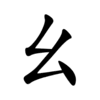幺
| ||||||||
Translingual
| Stroke order | |||
|---|---|---|---|
 | |||
Han character
幺 (radical 52, 幺+0, 3 strokes, cangjie input 女戈 (VI), composition ⿱𠃋厶(GHT) or ⿱𡿨厶(JK))
- Kangxi radical #52, ⼳.
Descendants
- ㄠ (Zhuyin alphabet)
References
- KangXi: page 341, character 12
- Dai Kanwa Jiten: character 9189
- Dae Jaweon: page 650, character 6
- Hanyu Da Zidian: volume 2, page 1092, character 14
- Unihan data for U+5E7A
Chinese
| simp. and trad. |
幺 | |
|---|---|---|
| variant forms | 么 | |
Glyph origin
| Historical forms of the character 幺 | |
|---|---|
| Western Zhou | Shuowen Jiezi (compiled in Han) |
| Bronze inscriptions | Small seal script |
 |
 |
| Characters in the same phonetic series (幺) (Zhengzhang, 2003) | |
|---|---|
| Old Chinese | |
| 幺 | *qiːw |
| 吆 | *qiːw |
Etymology 1
Pronunciation
Definitions
幺
Usage notes
- 么 is used instead of 幺 in mahjong and as a surname. Xiandai Hanyu Guifan Cidian (《现代汉语规范词典》) says '幺' and '么' are different characters.
Japanese
Kanji
幺
- This term needs a translation to English. Please help out and add a translation, then remove the text
{{rfdef}}.
Korean
Hanja
幺 • (yo) (hangeul 요, revised yo, McCune–Reischauer yo)
- This term needs a translation to English. Please help out and add a translation, then remove the text
{{rfdef}}.
Vietnamese
Han character
幺 (yêu)
- This term needs a translation to English. Please help out and add a translation, then remove the text
{{rfdef}}.
This article is issued from
Wiktionary.
The text is licensed under Creative
Commons - Attribution - Sharealike.
Additional terms may apply for the media files.